
 English
English
 French
French
An evaluation of using multiplex Real-Time PCR assay for the identification of factors causing hospital bacterial infections
Une évaluation de l’utilisation du test PCR en Temps Réel multiplex pour l’identification des facteurs responsables des infections bactériennes en milieu hospitalier
H. Nguyen Minh, M. Dao Quang, T. Tran Thanh
Thanh Nhan Hospital. Hanoi - Vietnam
Corresponding author
Dr. TRAN THANH Tu
Thanh Nhan Hospital. Hanoi - Vietnam
E-mail: tranthanhtu78bvtn@gmail.com
ABSTRACT
Introduction. To develop a multiplex real-time PCR for simultaneous rapid detection causing nosocomial such as Staphylococcus aureus, Acinetobacter Baumannii, Escherichia coli, Klebsiella pneumoniae and Pseudomonas aeruginosa.
Subjects and Methods. 143 samples were selected from 455 patients has been infected in the intensive care unit. The samples were divided into 2 parts, one of its cultured, other part used molecular biology technique compare the results obtained. The multiplex real-time PCR reaction have been optimized to ensure successful for amplification of the target genes. Sensitivity and consistency are based on culture results.
Results. Multiplex real-time PCR assay were employed to detection bacterial: Staphylococcus Aureus, Acinetobacter Baumannii, Escherichia coli, Klebsiella pneumonia, Pseudomonas aeruginosa.This had values compared culture method: sensitivity (97.6%), specificity (96.8%). Kappa coefficient shows that the two methods were very good similarities (ƙ value= 0.98, p <0.05).
Conclusions. Multiplex real-time PCR was a Rapid, high sensitivity, specificity method to detection batteries.
KEYWORDS: Reai-time PCR, S. Aureus, A. Baumannii, E. Coli, K. Pneumoniae; P. Aeruginosa; Sepsis.
RÉSUMÉ
Introduction. Développer une PCR multiplex en temps réel pour une détection rapide simultanée causant des nosocomiaux tels que Staphylococcus aureus, Acinetobacter Baumannii, Escherichia coli, Klebsiella pneumoniae et Pseudomonas aeruginosa.
Sujets et méthodes. 143 échantillons ont été sélectionnés parmi 455 patients infectés en unité de soins intensifs. Les échantillons ont été divisés en 2 parties, l'une de ses techniques de biologie moléculaire cultivée, l'autre partie utilisée comparent les résultats obtenus. La réaction PCR en temps réel multiplexe a été optimisée pour assurer le succès de l'amplification des gènes cibles. La sensibilité et la cohérence sont basées sur les résultats de la culture.
Résultats. Des analyses PCR en temps réel multiplexes ont été utilisées pour détecter les bactéries: Staphylococcus aureus, Acinetobacter Baumannii, Escherichia coli, Pneumonie de Klebsiella, Pseudomonas aeruginosa.Celles-ci avaient des valeurs comparées à la méthode de culture: sensibilité (97.6%), spécificité (96.8%). Le coefficient Kappa montre que les deux méthodes présentaient de très bonnes similitudes (valeur = 0,98, p <0,05).
Conclusions. La PCR en temps réel multiplexe était une méthode de détection bactérienne rapide et hautement sensible.
MOTS CLÉS: PCR en temps réel; S. Aureus; A. Baumannii, E. Coli, K. Pneumoniae; P. Aeruginosa; Sepsis.
INTRODUCTION
Hospital bacterial infections are still a problem even in developed countries. Statistics show that the prevalence of hospital bacterial infections is about 5-10% in developed countries and 15-20% in developing countries. The etiology causes hospital bacterial infections to have a higher degree of antibiotic resistance than infectious diseases in the community [1]. Hospital bacterial infection increases the treatment cost from 2 to 4 times, the duration of treatment lasts more from 7 to 15 days compared with normal bacterial infection. Each hour of delay in treating infections increases the mortality rate by 7.6% [2]. Cultured microorganisms is the most common method of detecting current bacteria in the blood and body disease. However, the method is limited in terms of time and sensitivity. For the early detection of microorganisms that cause bacterial contamination in the body, recent studies have given the new orientation that is the detection of specific DNA of bacteria. The detection of bacterial DNA in the patients’ medical samples presented a highly sensitive and precise method. Short detection time, which has a great significance in diagnosing bacterial infection. That's why research is done with the goal: Determine the value of the Real Multiplex-time PCR detection simultaneously Staphylococcus Aureus, Acinetobacter Baumannii, Escherichia coli, Klebsiella pneumoniae and Pseudomonas aeruginosa In a number of bacterial infections of the patients.
METHODS
Participants
455 patients at the ICU Department at Thanh Nhan and Duc Giang Hospital are diagnosed as bacterial infection after 48h hospitalization. From these patient, we collected samples of the disease such as blood, the suction fluid of bronchial, urine, purulent- leg catheters the lobes belonging to bacterial infections.
The sample of the disease includes: blood, urine, bronchial suction, purulent- leg catheters, sputum, these samples are divided into 2 parts, 1part is cultured nominal. Other is carried out by the molecular biology.
Equipment
Nanodrop Machine 1000, AriaMx Real time PCR System of Aligent manufacturer, Eppendorf Centrifuges ,, regular refrigerator, deep-volume refrigerators-200C, Incubators 370C, the Pipetman((10 µl, 20 µl, 100 µl, 200 µl, 1000 µl), stabilizer.
Chemical
The QIAgen's QIAamp @ DNA Mini Kit includes an extraction chemical, the pairs of decoy and samples of bacterial strains in multiplex-realtime PCR reactions are new designed. It is synthesized by IDT and tested by BLAST tools (http://www.ncbi.nih.gov) The order of primer and pattern is performed in Table 1.
Methods
Culturing method. Culturing, microbial isolation on agar environments: blood agar columbia, Chocolate agar , a culture bottle of biomerieux (using automatic blood transplants bact/ALERT 3D).
Bacterial identify: Based on the form, chemical bioproperties (using the identifier: Api 20E, Api 20NE, Api Stap)(Biomerieux manufacturer).
Multiplex Real-time PCR method
The total volume of a reaction consists of 10μl with the composition of the reaction that is reflected in Table 2.
RESULTS
The test results of the mixture of primer pairs, samples and target DNA
Based on the chart image of the DNA samples noticed the DNA samples of the bacteria Acinetorbacter baumannii, Klebsiella pneumoniae has fluorescent signals beyond the background fluorescence and a signal form of a standard realtime PCR standard.
The reference to the Ct value table finds that the special catch is quite early with the cycle of 12.93 and 10.93. This proves in the multiplex response of this realtime PCR of primer pairs and the pattern does not inhibit and does not initiate cross-pair each other. Similar test performed Staphylococus aureus, E. coli, Pseudomonas aeruginosa, Acinetobacter baumannii, Klebsiella pneumonia.
Sensitivity: (real positive/(real positive + false negative) * 100%. = (82/(82+2)*100%= 97.6%. Specification: Real negative/(real-negative + false positive) * 100%= 61/(61+2) *100%= 96.8%. The total of 143 samples of cultured microorganisms on blood samples, bronchial suction, sputum, purulent leg catheters with 82 positive specimens with at least 1 out of 5 microbes Acinetobacter baumannii, Klebsiella pneumoniae, E. coli, Staphylococcus aerus; Pseudomonas aeruginosa. Findings with the real-time PCR multiplex technique also detected 82 positive specimens, however, two cultured cases have not detected microbes, but molecular biology is found in the presence of microbes. There are 2 cases of microbial detection by culturing method but the realtime PCR multiplex technique is not detected. The sensitivity, the characteristic of which is credited in turn is 97.6% and 96.8%.
Based on the results in the chart notice that the DNA of the bacteria Staphylococus aureus, E. coli, Pseudomonas aeruginosa have a fluorescent signal beyond the background fluorescence and has the form of a signal of a standard realtime-PCR standard. The reference to the Ct value table is found to have a special pair of cycles of 22.48, 17.88 and 20.99 including in tubes with a mixture of 5 DNA target sequence composite (23.36; 17.00 and 21.17).
This proves in the multiplex reaction of realtime PCR decoy and special probe samples with the target gene, the primer and sample detectors do not inhibit and cross-pair each other.
Value of Multiplex real-time PCR KIT in identifying pathogenic microorganisms
In order to put the Multiplex realtime PCR method, which applied into practice to diagnose and quickly detect the bacteria that causes hospital infection we tested this method on various samples of the tablets are encoded to increase the objective of the study (Table 5).
In the 82 positive culturing form has 87 agents including 2 samples up at the same time, two agents in both the Culturing method and the molecular biology there are 3 additional samples 1 compared to cultured the similarity index of the 2 methods for 5 bacteria is very good the Kappa factor 0.92 (P < 0.05).
DISCUSSION
Determining the specification of the mixture of the primer pair and the sample of the target DNA.
Multiplex Realtime PCR reactions are designed based on PCR reactions single-primer pairs with the volume of a reaction of 10 μl including Master mix,primer, sample detector, DNA mold and deionized water. However in multiplex realtime PCR reactions have the addition of primer pairs and samples for simultaneous detection of many different genes.
The addition of this makes the concentration of components changed comparision with the standard realtime PCR , at the same time, possible phenomena of inhibition of the pair of inhibitors, cross-pair leading to the detection of the target gene.
Therefore after checking the catch of pairs of primer, the sample detector with its DNA is specific we conduct running Multiplex realtime PCR reactions with components and concentrations as shown above results in Figure 3.1 , 3.2. It shows that the special catch in reaction tube has 1 agent and the tube has many agents .This demonstrates KIT multiplex real-time PCR has good characteristics that can detect simultaneously multiple bacterial agents.
Values of KIT multiplex real-time PCR in identifying pathogenic microorganisms
Multiplex Real-time PCR is technically able to detect many types of microorganisms simultaneously on many different types of environments. Sensitivity, the specification of this method is quite high, the time of detection is short, it is useful in detecting early hospital infections. The result of the study of 143 microbiological samples cultured on as blood sample, the suction fluid of bronchial, urine, purulent- leg catheters, the level of real-time PCR is quite high in 97.6% and 96.8%. Comparison of the similarity of two methods on the sample of the medical samples are very good (kappa; 0.98; p < 0.05).
Yang. Q and Associates presented the application of the Multiplex Real-time PCR detection of Acinetobacter baumannii and Acinetobacter spp with a sensitivity and specification of 100% on sputum samples [3].
Wang HY also showed that the use of Real-time PCR detection of Staphylococcus Aerus in the blood with sensitivity and specification is 99.5 and 100%, molecular biology takes 3h, while the culture takes 48-72h [4]. The prevalence of microorganisms detection in the blood is lowest, 38.2% (cultured), 36.8% (PCR). This is practical due to the number of microorganisms (if any) in the blood often low. When it has a large of quantities it often has severe clinical manifestations.
The detection of the presence of microorganisms by PCR is more difficult than other biological epidemic due to the presence of multiple human DNA. It requires a high-specialty primer and probe design. In the 82 positive culturing samples, the researchers found 87 agents including two samples up at the same time ,two agents in both the Culturing method and the Molecular biology method ,there are 3 additional samples 1 compared to cultured .This result demonstrates that PCR is a highly sensitive method for detecting micro-organisms. The similarity index of the 2 methods for 5 bacteria is very good Kappa factor 0.92 (P < 0.05).
N Reyes MP and Associates used real-time PCR quantitative detection of the rapid antibiotic resistance by Acinetobacter baumannii. The author uses the ompA gene taken over 48 comparative medical samples with the results of culture, reaching 95.8%. Specification (97.5%), sensitivity (92.9%) positive predictive value (95,6%) negative predictive value (96.0%). Real-time PCR results are reliable. Distinguish between strains of resistance and non-antibiotic resistance [5]. Nomanpour B and Associates use real-time PCR determines the Acinetobacter baumannii agent pneumonia. The author uses real-time TaqMan PCR-based method of blaoxa-51which is designed and used for direct detection of A. baumannii from 361 respiratory diseases samples of patients who have a pneumonia. All samples are checked in parallel with conventional culturing method. Result: Real-time PCR can detect less than 200 CFU/ml patients’medical sample and the results are completely similar to the cultured (Kappa value 1.0, value p < 0.001). Sensitivity, specification, predictive value of real-time PCR is 100% [6].
CONCLUSION
Create KIT multiplex Real-time PCR detects simultaneous 5 kinds of microorganisms that cause hospital bacterial infection: Acinetobacter baumannii, Klebsiella pneumoniae, E. coli, Staphylococcus aerus; Pseudomonas aeruginosa. Sensitivity, specification is 97.6% and 96.8% compared to the culturing method. There is very good similarity between the Real-time PCR multiplex method with the Culturing method (Ƙ: 0.98; p < 0.05).
CONFLIT OF INTERESTS
The authors declare no conflict of interest.
REFERENCES
1. Abraham, S., et al., Carbapenemase-producing bacteria in companion animals: a public health concern on the horizon. J Antimicrob Chemother, 2014. 69(5): p. 1155-7.
2. Anand, D., et al., Procalcitonin as a rapid diagnostic biomarker to differentiate between culture-negative bacterial sepsis and systemic inflammatory response syndrome: a prospective, observational, cohort study. J Crit Care, 2015. 30(1): p. 218.e7-12.
3. Yang, Q. and Y. Rui, Two Multiplex Real-Time PCR Assays to Detect and Differentiate Acinetobacter baumannii and Non- baumannii Acinetobacter spp. Carrying blaNDM, blaOXA-23-Like, blaOXA-40-Like, blaOXA-51Like, and blaOXA-58-Like Genes. PLoS One, 2016. 11(7): p. e0158958.
4. Wang, H.Y., et al., Comparison of multiplex real-time PCR and PCR-reverse blot hybridization assay for the direct and rapid detection of bacteria and antibiotic resistance determinants in positive culture bottles. J Med Microbiol, 2016. 65(9): p. 962-74.
5. Martin-Pena, R., et al., Rapid detection of antibiotic resistance in Acinetobacter baumannii using quantitative real-time PCR. J Antimicrob Chemother, 2013. 68(7): p. 1572-5.
6. Nomanpour, B., et al., Rapid, cost-effective, sensitive and quantitative detection of Acinetobacter baumannii from pneumonia patients. Iran J Microbiol, 2011. 3(4): p. 1629.
FIGURES - TABLES
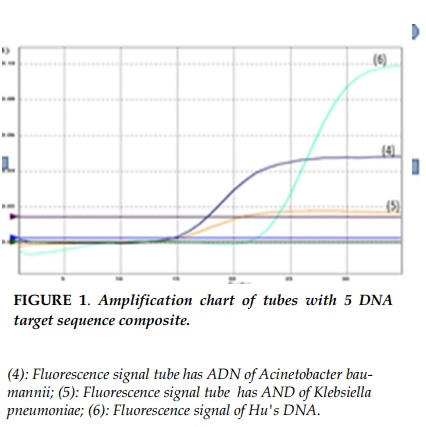
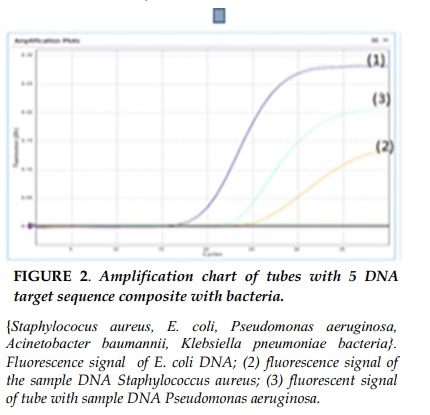

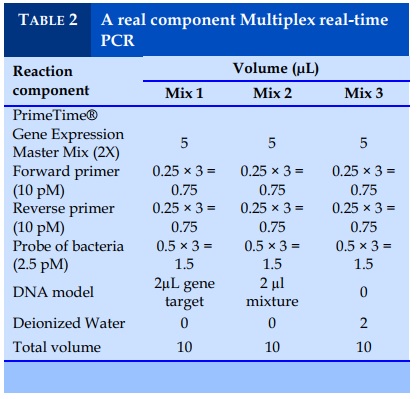
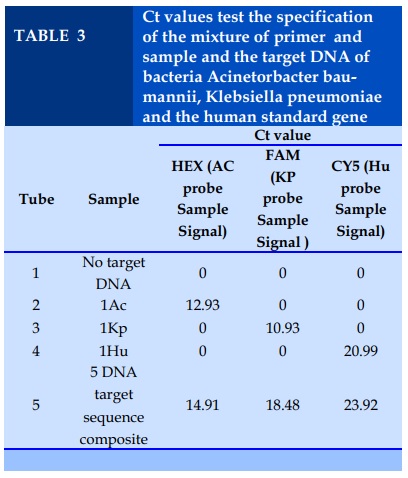
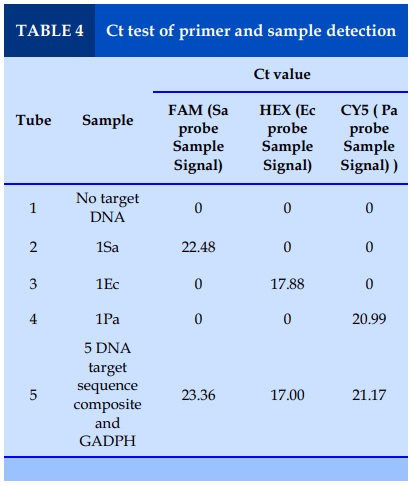
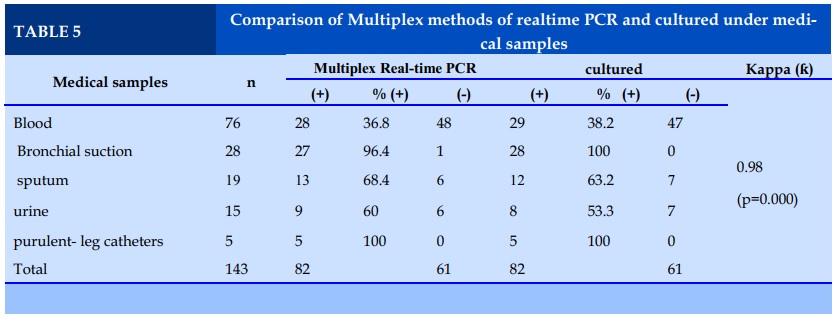

REFERENCES
1. Abraham, S., et al., Carbapenemase-producing bacteria in companion animals: a public health concern on the horizon. J Antimicrob Chemother, 2014. 69(5): p. 1155-7.
2. Anand, D., et al., Procalcitonin as a rapid diagnostic biomarker to differentiate between culture-negative bacterial sepsis and systemic inflammatory response syndrome: a prospective, observational, cohort study. J Crit Care, 2015. 30(1): p. 218.e7-12.
3. Yang, Q. and Y. Rui, Two Multiplex Real-Time PCR Assays to Detect and Differentiate Acinetobacter baumannii and Non- baumannii Acinetobacter spp. Carrying blaNDM, blaOXA-23-Like, blaOXA-40-Like, blaOXA-51Like, and blaOXA-58-Like Genes. PLoS One, 2016. 11(7): p. e0158958.
4. Wang, H.Y., et al., Comparison of multiplex real-time PCR and PCR-reverse blot hybridization assay for the direct and rapid detection of bacteria and antibiotic resistance determinants in positive culture bottles. J Med Microbiol, 2016. 65(9): p. 962-74.
5. Martin-Pena, R., et al., Rapid detection of antibiotic resistance in Acinetobacter baumannii using quantitative real-time PCR. J Antimicrob Chemother, 2013. 68(7): p. 1572-5.
6. Nomanpour, B., et al., Rapid, cost-effective, sensitive and quantitative detection of Acinetobacter baumannii from pneumonia patients. Iran J Microbiol, 2011. 3(4): p. 1629.
ARTICLE INFO
DOI: 10.12699/jfvpulm.10.31.2019.15
Conflict of Interest
Non
Date of manuscript receiving
15/4/2019
Date of publication after correction
17/6/2019
Article citation
Nguyen Minh H, Dao Quang M, Tran Thanh T. An evaluation of using multiplex Real-Time PCR assay for the identification of factors causing hospital bacterial infections. J Func Vent Pulm 2019;31(10):9-14.